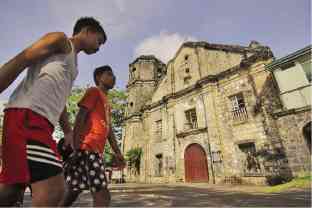Church rebuilt after Mayon blasts now important cultural property

CULTURAL TREASURE The St. John the Baptist Parish Church in Camalig town in Albay province has joined the list of cultural treasures of the country following a declaration from the National Museum of the Philippines. —GEORGE GIO BRONDIAL
CAMALIG, Albay—School teacher Agnes Nebres, 60, never paid attention to the architectural details of the St. John the Baptist parish church here.
According to Nebres, the church where she and her seven children have been regularly attending Masses is more than a structure. It is a symbol of her town mates’ enduring faith.
But Nebres was among those who were proud after the National Museum of the Philippines declared the church an “important cultural property” of the country.
Ma. Estela Espinas, 44, parish treasurer, said she was happy for the recognition.
“We are expecting an influx of tourists following the declaration. Most likely, they will come during the Lenten season for the Visita Iglesia,” Espinas said.
Article continues after this advertisement“As parishioners, we are honored that our church is considered as a valuable entity,” Nebres said.
Article continues after this advertisementJed Villanueva, Camalig tourism officer, said the church was the oldest structure in town and was built and managed by Franciscan missionaries for over 400 years, from 1579 to 1983, according to its marker.
“The church has served as refuge and shelter for residents during World War II and when the Americans came to liberate the country [from the Japanese],” he said.
The original church existed as wood and nipa structure from 1579 to 1580.
The second church, built from stone in 1605, was destroyed by successive eruptions of Mayon Volcano from 1766 to 1814.
Two priests, Francisco Latoba and Manuel Brihuega, helped rebuild the church in 1837. Construction of the facade, belfry and Escuela Catolica was supervised by Fr. Miguel Barcela in 1845.
The present church, which dates back to this period in the 1800s and built from blocks of lava rocks created by local stonecutters, has survived several typhoons.
The Department of Tourism (DOT) described the church as “one of the strongest and massive churches in the Bicol region.”
Maria Nini Ong-Ravanilla, DOT Bicol director, said the declaration was timely because Camalig had been identified by the Albay provincial government as a heritage town.
“Combining [history and] cultural heritage is a good come on for tourists. After all, Filipinos are religious in nature,” she said.
Legazpi Bishop Joel Baylon said churches, like the St. John the Baptist church, were important witnesses to the growth of faith in communities.
“They … remind us of the faith of those who came before us, how they expressed and lived this faith, what sacrifices they made and how it influenced their daily lives,” Baylon said.
Albay Rep. Joey Salceda said local officials were preparing for the recognition and inscription of 15 churches in the province by the National Historical Commission of the Philippines as national cultural treasures.
Villanueva said the declaration meant that funds would be available for the preservation and restoration of the church.